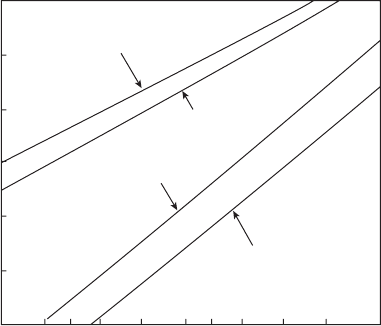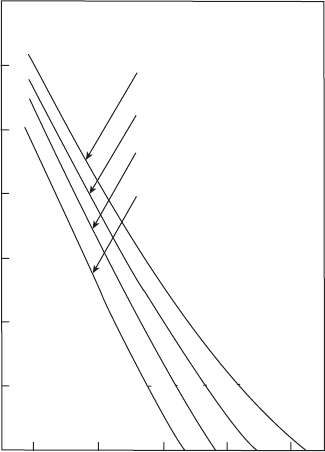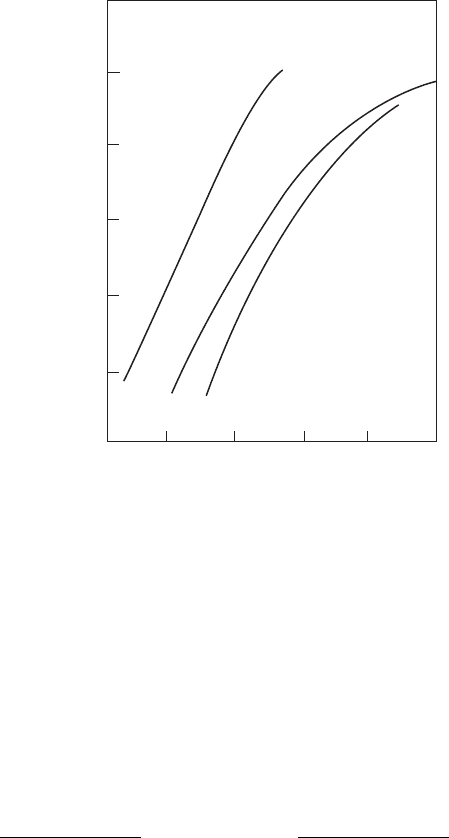Lefebvre A.H., Ballal D.R. Gas Turbine Combustion: Alternative Fuels and Emissions
Подождите немного. Документ загружается.


460 Gas Turbine Combustion: Alternative Fuels and Emissions, Third Edition
density is shown for petroleum fuels in Figure 10.9. The minimum ash
point of Jet A kerosine-type fuel is 38°C (100°F). The US Navy uses a high
ash-point (60°C) kerosine-type JP-5 fuel on aircraft carrier because of safety
considerations.
10.4.5 Volatility Point
The volatility of a fuel may be assessed from a knowledge of its distil-
lation range, vapor pressure, and ash point. Increased volatility affects
combustion performance by providing easier lightup, improved stability,
and higher combustion efciency. These advantages are most apparent
when combustion performance is limited by poor fuel atomization. The
disadvantages of high volatility, as touched on above in connection with
vapor pressure, are excessive fuel evaporation losses at high altitude and
increased re hazard. The correlation between volatility and ash point is
shown in Figure 10.10.
10.4.6 Viscosity
Viscosity is a physical property that depends mainly on the chemical com-
position of the hydrocarbons contained in the fuel [1]. Apart from affecting
the power required to pump the fuel through the fuel system, viscosity has
marked effect on the formation of a well-atomized spray and hence on the
rates of fuel evaporation and combustion. The higher the viscosity of a fuel,
the poorer the quality of atomization. Modern fuel-injection systems are
500
460
JP5
JP4, Jet B
Jet A, A-1
Avgas
420
380
340
300
Temperature, K
260
1 23 5
Vapor pressure, kPa
10 20 30 50 100 200 500
Figure 10.8
Effect of temperature on true vapor pressures of aviation fuels.

Alternative Fuels 461
capable of providing satisfactory pressure atomization with fuel viscosities
up to around 15 × 10
–6
m
2
/s, depending on the design of the atomizer and
the available fuel-injection pressure. The performance of airblast atomizers
is fairly insensitive to fuel viscosity, a signicant advantage over atomizers
of the pressure type [21].
700
600
500
400
300
0.7
0.8 0.9
1.0
Temperature, K
Ignitable fuels
Gasolines
Kerosines
Gas oils
Diesel fuels
Ambient
Flammable fuels
Relative density
Fuel oils
Flash
point
Spontaneous
ignition
temperature
Figure 10.9
Ignition temperatures for petroleum fuels.
Gas oils
Kerosenes
Avtur
JP2
JP4
Avgas (approx.)
200
600
550
500
450
400
350
300
250 300
Flash point, K
10% Distillation temperature, K
350 400 450
Figure 10.10
Relationship between ash point and volatility.

462 Gas Turbine Combustion: Alternative Fuels and Emissions, Third Edition
The viscosity of gas turbine fuels depends greatly on temperature, as illus-
trated in Figure 10.11. Thus, heavy oils and residual fuels must usually be heated.
Also, for aviation fuels, the increased viscosity at low temperatures (currently
12 × 10
–6
m
2
/s for starting) dictates the minimum operating temperature at
which a satisfactory spray can be obtained for starting and/or altitude relight.
10.4.7 Surface Tension
Usually there are no specication limits on surface tension for gas turbine
fuels. However, surface tension has a signicant effect on fuel atomization,
since, for both pressure and airblast atomizers SMD
∝σ
F
06.
. Some typical val-
ues of surface tension and their variation with temperature are shown in
Figure 10.12.
10.4.8 Freezing Point
Aircraft operate most economically at high altitude where ambient tempera-
ture may be as low as 193 K. Because jet fuel is a complex mixture of many
individual hydrocarbons, it does not freeze at one temperature like water.
Hydrocarbons with highest freeze point solidify rst, forming wax crystals;
later, lower freeze point components solidify. The freezing point of the jet
10.0
5.0
2.0
1.0
0.5
0.4
260 280 300
Fuel temperature, K
Avtur
Kinematic viscosity, m/s
2
× 10
–6
Avgas
Avtag (JP4)
Avcat (JP5)
Diesel oil
320 340 360
Figure 10.11
Viscosity-temperature characteristics of typical fuels.

Alternative Fuels 463
fuel is dened as the temperature at which the last wax crystals melt when
warming the solidied fuel. The primary engineering criterion is fuel pump-
ability, which is the ability to move highly viscous fuel from fuel tank to
engine. Industry uses freezing point as an indicator of fuel low-temperature
pumpability, which is approximately 5°C to 15°C below its freezing point.
The temperature at which a fuel rst shows the presence of solid particles
or wax crystals (as its temperature is decreased) is called its freezing point.
Aircraft fuel specications stipulate a maximum freezing point of 227 K
(–51°F) or 215 K (–73°F), according to the type of service.
In general, the presence of iso-parafn compounds in lieu of normal par-
afns decrease freeze point. Thus, the rening process should be tailored
to increase the yield of iso-parafnic kerosine (IPK) in jet fuel. Figure 10.13
shows the relationship between freezing point and the number of carbon
atoms. The relationship between freezing point and boiling point [22] is
illustrated in Figure 10.14.
10.4.9 Specific Heat
In modern aircraft, fuel may be used as a heat sink to absorb heat from
the airframe and engine. The specic heat is thus an important property
0.028
0.024
0.020
0.016
0.012
Surface tension, N/m
0.008
0.004
0
300
400
500
600 700
Te mperature, K
Relative density
0.84
0.80
0.76
0.72
Figure 10.12
Surface tension-temperature relations for various hydrocarbon fuels.

464 Gas Turbine Combustion: Alternative Fuels and Emissions, Third Edition
of the fuels burned in these aircraft. Parafnic fuels are the most attrac-
tive in this regard because they have considerably higher specic heats
than either naphthenic or aromatic fuels [23–25]. Values of specic heat for
kerosine-type fuels are plotted in Figure 10.15. For other liquid petroleum
fuels, the specic heat may be estimated with reasonable accuracy from the
expression
c
T
d
c
r
p
f
p
kJ kg Kor=
+
⋅
(
)
=
+07600033503880
05
..
/
.
.
..
.
.
00045
05
T
d
r
f
Btu/lb F.
For fuel vapor:
cTd
pfr
kJ/kgKor=+
(
)
⋅
(
)
=
0136 00012 4
01
.. (– )
(.005 000016 4+⋅
(
)
.)(– ).Td
fr
Btu/ lb F
280
260
240
220
200
59 13 17 21 25
Aromatics
Number of carbon atoms
Freezing point, K
Naphthenes
Paraffins
Figure 10.13
Relationship between freezing point and number of carbon atoms. (From Hager, J.A., SAE J.,
74, 38, 1966.)

Alternative Fuels 465
10.4.10 Latent Heat
The latent heat of evaporation at the average boiling point of the fuel may be
related to relative density and fuel temperature by the expression
L
T
d
L
T
d
=
−
=
−360 039 115 01.
/
.
.
f
r
f
r
kJ kg or Btu/lb
10.4.11 Thermal Conductivity
The thermal conductivity of a liquid petroleum fuel is given by:
k
T
d
k=
−
⋅
(
)
=
−0 134 0000063 0065 0 0000..
/
..
f
r
WmKor
2206T
d
f
r
Btuhft F/.⋅⋅
(
)
700
450
220 240
Freezing point, K
260
500
550
600
Final boiling point, K
650
Figure 10.14
Effect of freezing point on nal boiling point.

466 Gas Turbine Combustion: Alternative Fuels and Emissions, Third Edition
10.5 Combustion Properties of Fuels
The combustion properties of most interest are those that govern the ame
temperature, the rate of chemical reaction, the burning range, and the ten-
dency to form soot.
10.5.1 Calorific Value
The caloric value of a fuel is a measure of the heat librated when it is burned
to completion under standard conditions. For gas turbine fuels, the lower
caloric value is most relevant, since it pertains to complete combustion to
CO
2
and H
2
O vapor. On a gravimetric basis, caloric value is now described
as specic energy; and on a volumetric basis, as energy density. For most
hydrocarbon fuels, the specic energy can be related to the relative den-
sity, as shown in Figure 10.16. In general, the heaviest fuels have the highest
energy density, while the lightest fuels have the highest specic energy. The
choice of fuel for aircraft applications will depend on whether tankage space
is limited, as in ghter aircraft, or if range is limited by all-up weight, as in
most freight aircraft.
The specic energy of a fuel depends entirely on its chemical composition
and, in particular, on the hydrogen/carbon ratio. Several empirical formulas
have been derived for calculating the heat of combustion of a fuel from an
Avgas
JP4, Jet B
Jet A
JP5
260
1.8
2.0
2.2
2.4
2.6
2.8
Specific heat, KJ/(kg·K)
3.0
3.2
300 340 380
Temperature, K
420 460 500 540
Figure 10.15
Inuence of temperature on specic heat.

Alternative Fuels 467
analysis of its constituents. Ragozin [26] recommends the following formula,
which is attributed to Mendeleyev:
LSECHOSW,=+
(
)
0 339 10301090025..–. ––.
where LSE is the lower specic energy of the fuel in megajoules per kilo-
gram, and C, H, O, S, and W are the mass percentages of carbon, hydrogen,
oxygen, sulfur, and water, respectively, in the fuel.
If the chemical composition of the fuel is unknown, the heat of combustion
can be estimated with less precision from the relative density alone, using
the equation
LSEMJ/kg.
r
=
−
51 5
595
153
.–
.
. d
The energy density of gaseous fuels is usually expressed either in megajoules
per cubic meter or Btu per cubic foot. Since the amount of heat produced by a gas
burner does not depend solely on the volumetric heat release, a quantity known
as the Wobbe index is often used in comparing gaseous fuels and in preliminary
assessment of the design requirements for the fuel system. It is dened as
Wobbe index=
Energy density
Relative density
.
0.7 0.8
Relative density
44
43
42
41
Lower specific energy, MJ/kg
40
19,000
18,000
Lower specific energy, Btu/lb
17,000
0.9 1.0
Residual oils
Gas and diesel oils
Kerosenes
Gasolines
Figure 10.16
Variation of specic energy with relative density of fuels.

468 Gas Turbine Combustion: Alternative Fuels and Emissions, Third Edition
Essentially, the Wobbe index provides a measure of the energy throughput
for a given size of gas discharge orice. Normally, it should not be allowed
to vary by more than about 5% from the nominal value for which the system
was designed.
10.5.2 enthalpy
The enthalpy of a fuel is a measure of its capacity to absorb heat; the enthalpy
also indicates the amount of heat required to accomplish a given change in
the temperature or state of a fuel. Enthalpy diagrams of the type shown in
Figure 10.17 for Jet A fuel, may be constructed for any fuel from its latent heat,
distillation characteristics, and specic heats. The curve marked “liquid”
represents the amount of absorbed heat in the liquid phase alone. Enthalpy
diagrams for other kerosine-type fuels are contained in Reference [27,28].
As an example of the use of enthalpy diagrams, consider a Jet A fuel in the
liquid phase at an initial temperature of 300 K. Its initial enthalpy is 250 kJ/
kg, as shown by the saturated-liquid curve at 300 K. Assume that 800 kJ/kg
is to be added to this fuel, giving a nal enthalpy of 1050 kJ/kg. This heat can
be added in several ways:
1. The fuel can be retained in the liquid phase. The nal temperature
will then have to be 600 K, as indicated by the temperature of satu-
rated liquid at an enthalpy of 1050 kJ/kg. A pressure in excess of 1.8
MPa would be required to keep the fuel liquid.
0
300 400 500
Temperature, K
Pressure, MPa
Percent vaporized
20%
40%
60%
80%
0.1
0.7
1.4
2.0
Vapor
Liquid
Enthalpy, kJ/kg
600700
200
400
600
800
1000
1200
1400
1600
Figure 10.17
Enthalpy of Jet A fuel.
Alternative Fuels 469
2. The fuel can be completely vaporized. The nal temperature of the
vapor will then have to be 522 K, as shown by the saturated-vapor
curve at an enthalpy of 1050 kJ/kg.
3. The fuel can be partially vaporized at a temperature between 522
and 600 K, depending on the pressure. For example, at a pressure of
0.7 MPa, partial vaporization would yield a liquid-fuel-vapor mix-
ture at a temperature of 567 K, with about half the total fuel in the
form of vapor.
10.5.3 Spontaneous-ignition Temperature
An important factor affecting aircraft re and explosion hazards is the ten-
dency of the fuel toward spontaneous ignition. When an aircraft crashes, a
common cause of re is the spontaneous ignition of fuel coming into con-
tact with hot surfaces, especially near engines. The problem is especially
important for high-speed aircraft because of kinetic heating of the aircraft
structure. Above altitudes of 11 km, at about Mach 2.7, the leading edge of
an aircraft attains a temperature that just exceeds the spontaneous-ignition
temperature (SIT) of the fuel.
The SIT depends greatly on molecular structure, since the oxidation
reactions leading to spontaneous ignition can occur only when the chemical
bonds within the fuel are broken by thermal agitation. Consequently, the
SIT is lower for fuels with higher relative density, whose molecules are less
compact and more vulnerable to cracking [1]. Straight-chain parafns are
more easily ignited than either branched-chain parafns or cycloparafns
containing the same number of carbon atoms. Very highly branched com-
pounds and aromatics are highly resistant to spontaneous ignition [29].
The SIT is usually measured by injecting a small sample of the fuel into
a heated crucible or ash and noting the delay until the onset of ignition.
The test is repeated at lower temperatures (with associated longer delays),
until the minimum ignition temperature is found [1]. Some typical results
are shown in Figure 10.9.
Generally, for a hydrocarbon fuel, the SIT increases with decreasing pres-
sure. Tests carried out on a JP-4 fuel [30] showed that decreasing the pressure
to one-third its original value increased the SIT by a factor of 2.
A number of workers have investigated the effect of additives on the SIT of
aviation fuels. Thomas [31] examined a number of additives, the most effec-
tive being tetraethyl lead. In a concentration of 3 mL per imperial gallon, this
additive increased the minimum pressure needed to produce spontaneous
ignition from 27.6 to 40.7 kPa. Tetraethyl lead is added as part of a mixture
that also contains ethylene dibromide and dye. Ethylene dibromide acts as a
scavenger for lead oxide and reacts to produce a mixture of lead bromide and
lead oxybromides. These compounds are volatile and are exhausted from
the engine; in this manner, deposits of lead oxide are prevented from collect-
ing on valves and spark plugs. Of the number of additives investigated by
